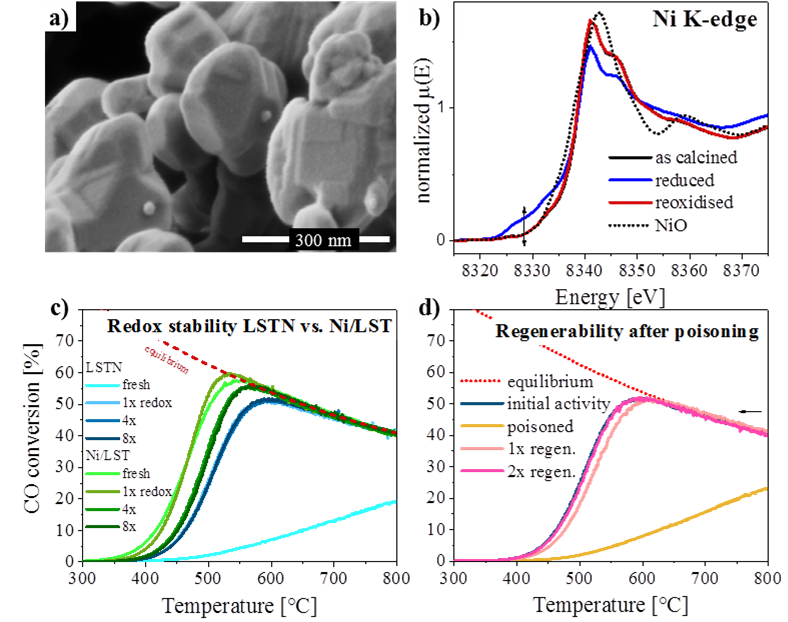Microstructural self-regeneration of LaSrTiNiO3-δ: fast recovery from sulfur poisoning
Poisoning by sulfur is a common problem for Ni catalysts as well as solid oxide fuel cells (SOFCs). It is widely accepted that the deactivation in SOFCs is due to the poisoning of Ni sites active for the water gas shift reaction (WGS, CO + H2O → CO2 + H2). This reaction provides additional H2 for oxidation when the cell is operated on syngas feeds [1]. Current SOFC materials cannot easily be regenerated after sulfur poisoning. Some perovskite type metal oxides (PMO) exhibit the remarkable reversible segregation of catalytically active metals from and reincorporation back into the PMO host lattices. This was found to be highly efficient in inhibiting sintering of metal particles during redox cycling [2,3]. This redox stability was applied on Ni to develop a water gas shift active and regenerable SOFC anode material. It can be shown that after reduction at 800 °C Ni is selectively reduced and segregated to the LaSrTiNiO3-δ (LSTN) surface where it forms catalytically active, metallic Ni particles of few tens nm in size (Fig. 1-a) [3]. After reoxidation Ni is fully reincorporated into the perovskite lattice as shown by Ni K-edge XANES (Fig. 1-b). Catalytic data for the WGS reaction obtained over a number of redox cycles and Ni particle size analysis show the excellent redox stability of this material and demonstrate inhibition of Ni particle sintering. For comparison, redox cycling of an impregnated material (Ni/LST) leads to sintering and severe loss of catalytic activity over a few redox cycles (Fig. 1-c). Exposure of LSTN to H2S caused an expected loss of catalytic activity (Fig. 1-d), which again can be completely restored within two redox cycles.

Figure 1. a) SEM image of reduced LSTN - segregated Ni particles on LSTN crystallites. b) Ni K-edge XANES of calcined, reduced and reoxidised LSTN. c) CO conversion for pre-reduced LSTN and Ni/LST over 8 redox cycles and d) after H2S poisoning and over two oxidative regeneration cycles.
From a material and methodological point of view it is demonstrated that the structural reversibility exhibited by some PMOs can be exploited to completely regenerate S-poisoned catalysts which otherwise would suffer from deactivation by particle sintering. This function can be potentially applied to a variety of Ni catalyzed reactions suffering from similar deactivation phenomenon.
[1] Kuhn, J.N., Lakshminarayanan, N., and Ozkan, U.S., J. Mol. Catal. A, 2008, 282
[2] Nishihata, Y., Mizuki, J., Akao, T., Tanaka, H., Uenishi, M., Kimura, M., Okamoto, T., and Hamada, N., Nature, 2002, 418
[3] Burnat, D., Kontic, R., Holzer, L., Steiger, P., Ferri, D., and Heel, A. J. Mater. Chem. A, 2016, 4